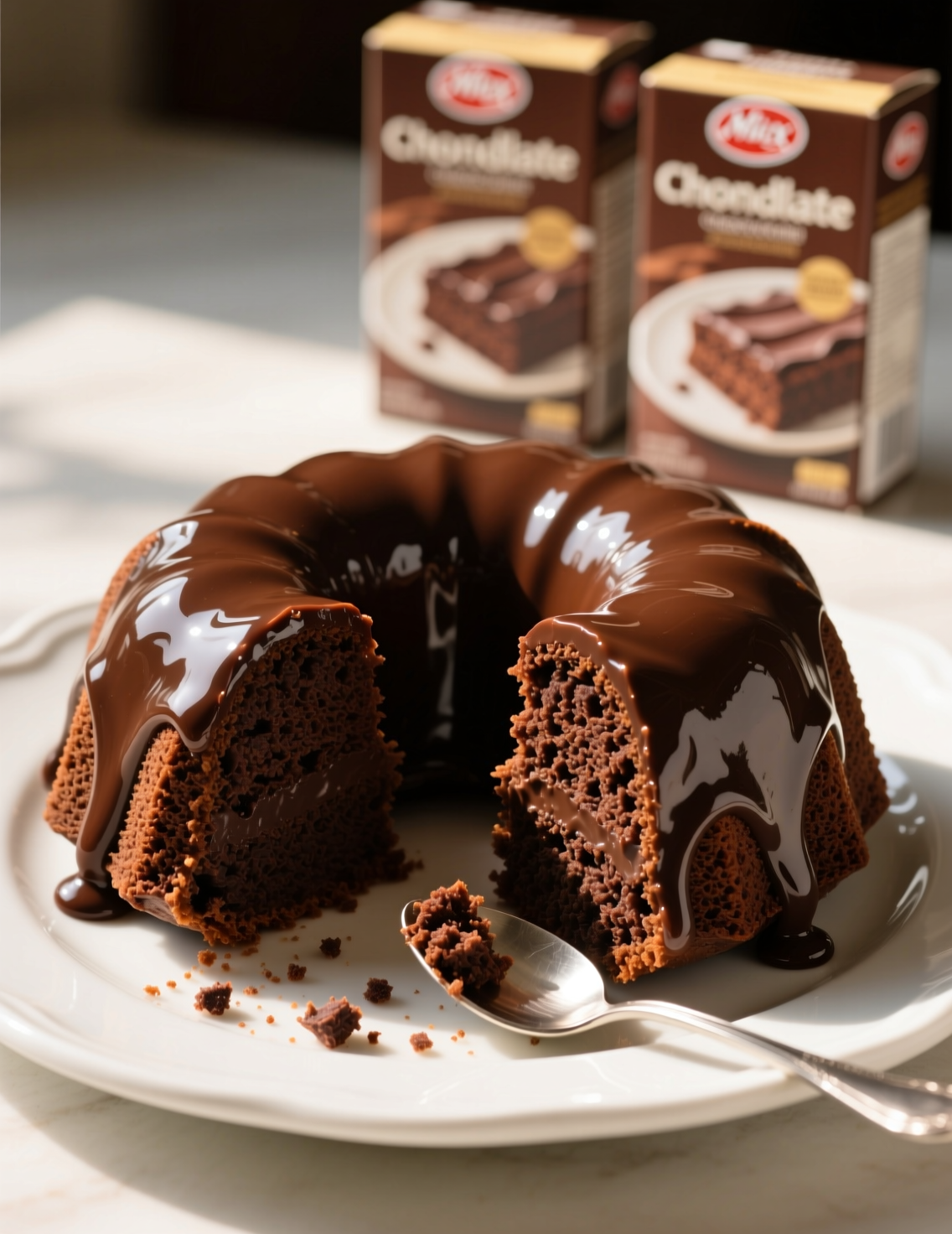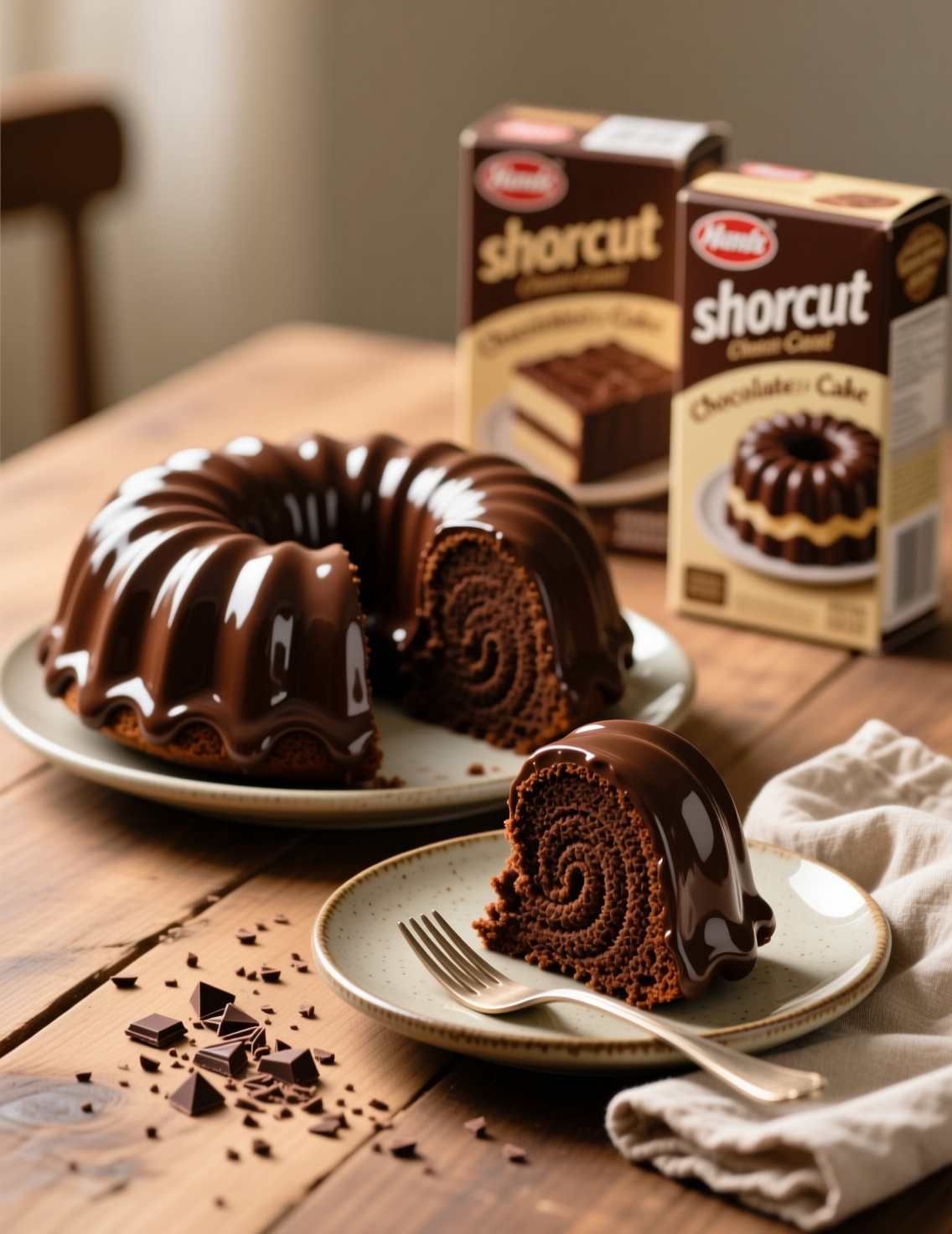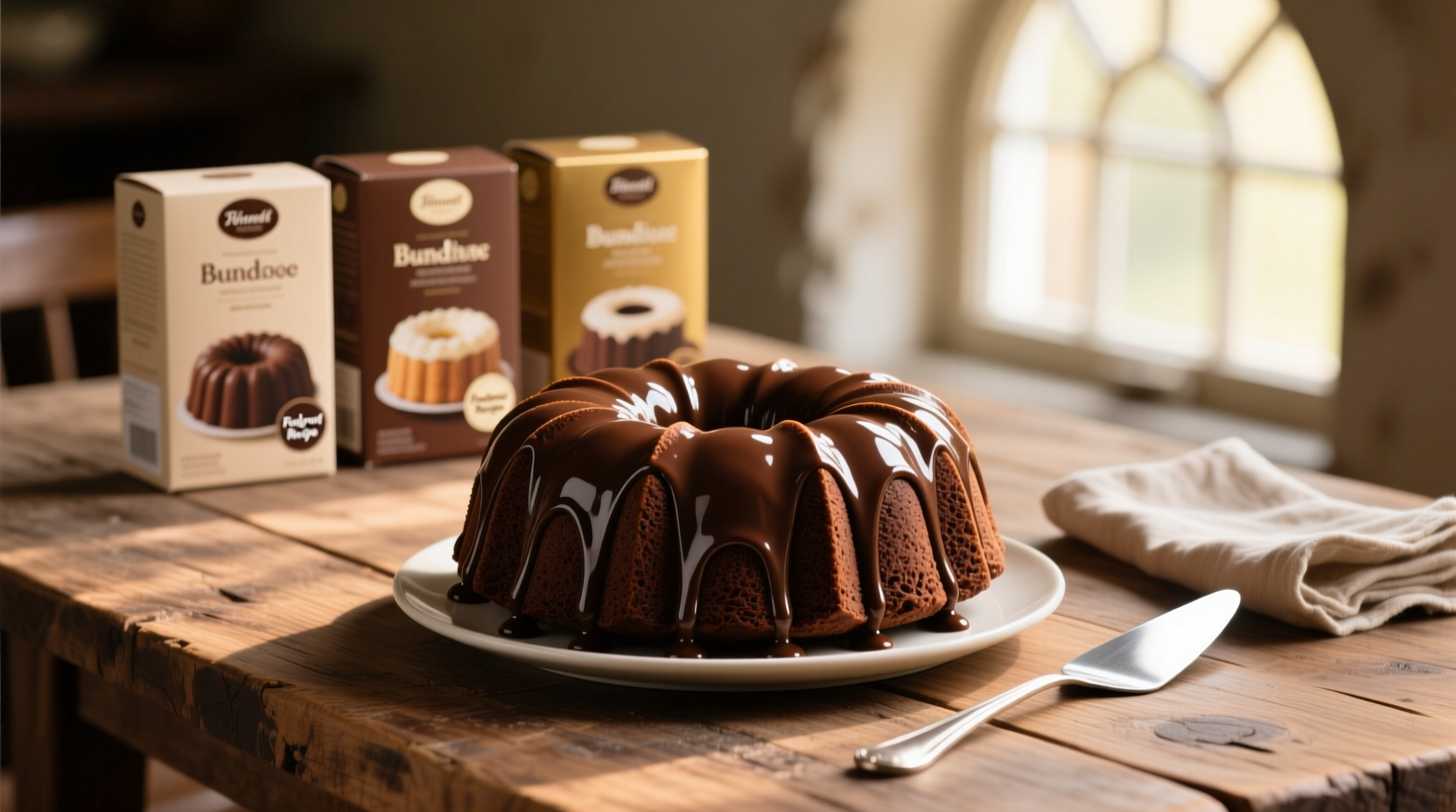There’s something oddly magical about the shape of a Bundt cake. The deep ridges, the golden crust, the way light catches the glossy glaze that drips lazily down its sides. Now imagine achieving all that beauty — and flavor — without starting from scratch. That’s where the humble cake mix box steps in, like a silent kitchen hero that too many underestimate. Today, we’re diving into the expert world of creating a Chocolate Bundt Cake With Cake Mix Boxes Recipe, the right way — rich, moist, and embarrassingly easy, yet professional enough to stand proud at a fine dining table.
Let’s be honest — most boxed cake mix directions on the back are, well, basic. But with a few technical tweaks, that store-bought mix transforms into something that tastes like it came from a pastry chef’s private kitchen. I’ll walk you through why it works, how to tweak the science behind it, and the small, sneaky techniques that make a huge difference.
The Science Behind Box Cake Mix Magic
Most boxed cake mixes (like Duncan Hines, Betty Crocker, or Pillsbury) are precisely balanced. That means the ratio of flour, sugar, leaveners, and emulsifiers is already chemically calibrated to produce a tender crumb every time. The issue? That precision also makes them a bit predictable — too light, too airy, lacking that rich density that makes a true Bundt cake feel luxurious.
Professional bakers often “doctor up” mixes. Not because they’re lazy, but because mixes provide a consistent, controlled base. Think of it as starting with a solid blueprint instead of sketching the architecture from scratch. The goal is to manipulate texture, flavor, and moisture — to make that predictable box sing.
Adding ingredients like sour cream, instant pudding mix, or brewed coffee changes the chemistry in subtle but dramatic ways. Fats and acids alter gluten formation and retain moisture, while the added starches from pudding mix thicken the batter, making it bake up denser and more luscious. It’s part science, part craft, and yes, part rebellion against the boring directions on the back of the box.

Ingredients You’ll Need (For 4–6 servings, though you’ll wish you’d doubled it)
- 1 box (15.25 oz) of chocolate cake mix (Devil’s Food or Dark Chocolate is ideal)
- 1 box (3.9 oz) instant chocolate pudding mix
- 4 large eggs, room temperature
- 1 cup sour cream (full-fat, please — don’t ruin this with light stuff)
- ½ cup vegetable oil
- ½ cup warm water
- ½ cup brewed black coffee (cooled slightly)
- 1 cup semi-sweet chocolate chips or chopped chocolate chunks
Optional but highly recommended: 1 teaspoon pure vanilla extract or ½ teaspoon espresso powder for flavor depth.
You could add a pinch of sea salt too. Chocolate loves salt — it makes the flavor bloom, almost like sunlight hitting dark soil after rain.
Method: Turning a Mix into a Masterpiece
Preheat your oven to 350°F (175°C). Grease your Bundt pan generously. And when I say generously, I mean like you’re trying to bribe it to release the cake later. Use softened butter and dust lightly with cocoa powder, not flour — it keeps the color rich and even.
In a large mixing bowl, combine the cake mix and pudding mix first. It seems simple, but that dry blending step prevents clumps later. Then, add eggs, sour cream, oil, coffee, and water. Beat on low speed for 30 seconds, then medium for about 2 minutes. You’ll notice the batter thicken almost immediately — that’s your emulsifiers and fats working together.
Now fold in the chocolate chips gently with a spatula. Don’t overmix; you’re not whipping air here. Pour the batter into the prepared Bundt pan, tapping it lightly on the counter to release any air bubbles.
Bake for 45–50 minutes. Check at 45 — you want the skewer to come out with a few moist crumbs. If it’s clean, you’ve overbaked by a smidge, and the crumb will dry out faster. Patience, here, is everything.
Once baked, let it cool in the pan for 10–15 minutes, then invert onto a wire rack. Don’t rush this. Bundt cakes are divas — pull them too soon, and they’ll tear. Wait too long, and they’ll stick like a bad habit.
The Secret Flavor Layer: Coffee, Pudding, and Chemistry
Here’s a trick seasoned pastry chefs swear by — coffee deepens chocolate’s flavor without making it taste like coffee. It enhances the natural cocoa notes, giving your cake that “how is this so chocolatey?” kind of richness.
The pudding mix is another quiet miracle worker. It not only thickens the batter but locks in moisture long after baking. This means your cake tastes as fresh on day three as it did out of the oven — something that’s hard to achieve even with scratch baking.
And sour cream? It’s the anchor. The acid interacts with baking soda and leavening agents, producing fine, tender crumb structure. Too much acid though, and you’ll collapse your rise — balance matters.
Glazing Like a Pro: The Shine Factor
A Bundt cake deserves a glaze that clings lovingly to every curve. You can go two ways: simple or extravagant.
For a simple glaze:
- 1 cup powdered sugar
- 2 tablespoons cocoa powder
- 2 tablespoons milk or heavy cream
- ½ teaspoon vanilla extract
Whisk till smooth, pour over cooled cake, and let it drizzle naturally. It should look imperfect — that’s where charm lives.
For something fancier, make a ganache. Heat ½ cup heavy cream until just simmering, pour over ¾ cup semi-sweet chocolate, let sit 3 minutes, then stir till glossy. You’ll get a sheen that could make mirrors jealous.
Pro trick: if you add a teaspoon of corn syrup to your ganache, you get that professional glossy finish that doesn’t dull as it sets.
Texture and Flavor Notes for Professionals
The perfect Bundt crumb should be tight yet yielding — a fine balance between structure and moisture. Overbeating your batter risks developing gluten, resulting in a slightly chewy cake. Underbaking leaves the center dense and gummy. Aim for that middle ground where every forkful feels velvety.
When you slice it, you’ll notice the deep, even color — no pale pockets or streaks. That’s proper mixing and even baking temperature control. If the crust looks too dark before the center sets, tent the cake loosely with foil in the final 10 minutes.
Professionals also pay attention to flavor balance. A cake that’s just sweet is flat. The salt, coffee, and cocoa work in harmony to create contrast — it’s like hearing a song in stereo instead of mono.

Common Mistakes Bakers Make
- Using cold eggs and sour cream. It’s a small thing but it messes with emulsification. Always bring dairy and eggs to room temperature.
- Skipping the pudding mix. It’s not optional; it’s the glue holding the magic.
- Overgreasing with spray oil. Spray can pool at the base and make the cake bubble weirdly. Use butter and cocoa powder for precision.
- Ignoring cooling times. Bundt cakes are notorious for sticking — let gravity and patience do the work.
- Overmixing chips. Fold, don’t stir aggressively. The less friction, the more tender your crumb.
Professional Tip: Flavor Variations
Chocolate bundt cake is a foundation for endless creativity. Add a teaspoon of orange zest for a dark-chocolate-orange profile. Or swirl in a ribbon of peanut butter for something a bit indulgent.
For the adventurous, try incorporating 2 tablespoons of bourbon into the batter and finishing with a chocolate-bourbon glaze. Alcohol enhances depth, though you’ll lose the sharpness during baking.
Another pro idea: brush the warm cake with a thin syrup made from equal parts sugar, coffee, and cocoa powder. This “soaking syrup” adds extra moisture and a luxurious finish — the kind that makes guests pause after the first bite.
Storage and Shelf Life Insights
This cake stores like a dream. Wrap tightly in plastic wrap or foil and keep at room temperature for up to 4 days. For longer storage, freeze it (un-glazed) for up to 3 months. Thaw at room temperature, then add glaze before serving.
Interestingly, Bundt cakes tend to taste better on day two. The flavors settle, merge, and deepen overnight. It’s one of those rare desserts that improves with a little patience.
Nutritional and Technical Considerations
Each slice (assuming 12) roughly carries 350–400 calories, depending on added chocolate and glaze type. Professionals often calculate not just calories but texture ratios: hydration percentage (liquid-to-dry ratio) is approximately 60–65% in this recipe — ideal for dense cakes.
The fat-to-flour ratio sits high due to sour cream and oil. This is intentional; it yields that luxurious mouthfeel people subconsciously associate with “homemade.”
Expert Troubleshooting
If your cake collapses slightly after cooling, you might’ve underbaked by a few minutes. Always use a digital thermometer — the internal temperature should read around 205°F when done.
If it sticks, run a thin silicone spatula gently along the edges and center tube while it’s still warm. Next time, check your greasing method — butter tends to outperform sprays in intricate pans.
A dry cake? That’s often from overbaking or skipping the pudding mix. Moisture retention is everything here. Consider brushing with a light syrup post-bake to revive texture.
A Note on Presentation
Presentation isn’t just vanity — it’s psychology. A glossy glaze, a few curls of dark chocolate, maybe a dusting of cocoa around the plate edge — those touches make people perceive the cake as richer, even before tasting it.
Bundt cakes photograph beautifully too. That symmetry, those curves — it’s architectural baking. Serve it on a pedestal stand, not a flat plate. Give it the height it deserves.
Conclusion: The Shortcut Worth Taking
Making a Chocolate Bundt Cake With Cake Mix Boxes Recipe isn’t cheating. It’s smart baking. It’s knowing when to let science and precision do the heavy lifting so you can focus on creativity and balance. The result? A cake that’s unapologetically rich, deeply chocolatey, and foolproof enough for weeknights yet impressive enough for celebrations.
Professionals understand that shortcuts aren’t about cutting corners — they’re about refining process efficiency. A boxed mix is a base; what you build on it is art.
And once you’ve tasted this version, you’ll probably never see those humble cake mix boxes the same way again. They’re not shortcuts — they’re secret weapons.
FAQs
What makes this Chocolate Bundt Cake with cake mix taste homemade?
Adding sour cream, pudding mix, and brewed coffee makes it denser, richer, and more flavorful than a basic box cake.
Can I use any brand of cake mix for this recipe?
Yes, any good-quality chocolate cake mix like Duncan Hines or Betty Crocker works perfectly.
Why do you add instant pudding mix to the batter?
It improves texture and moisture, giving the cake a bakery-quality crumb that lasts for days.
What does coffee do in a chocolate Bundt cake?
Coffee deepens and enhances the chocolate flavor without making it taste like coffee.
Can I skip the sour cream or use yogurt instead?
You can use full-fat Greek yogurt, but sour cream gives the best texture and richness.
How do I keep the Bundt cake from sticking to the pan?
Grease with butter and dust with cocoa powder instead of flour for a smooth release.
How long should I bake the cake?
Bake at 350°F for about 45–50 minutes, or until a skewer comes out with moist crumbs.
Can I make this recipe ahead of time?
Absolutely — it tastes even better the next day as the flavors settle and deepen.
How should I store leftover Bundt cake?
Wrap tightly in plastic wrap and keep at room temperature for up to 4 days.
Can I freeze this chocolate Bundt cake?
Yes, freeze it un-glazed for up to 3 months, then thaw and glaze before serving.
What’s the best glaze for this cake?
A chocolate ganache or simple cocoa glaze works beautifully, adding shine and depth.
Why use cocoa powder instead of flour when dusting the pan?
Cocoa keeps the cake’s color dark and rich while preventing white residue.
How do I know when my Bundt cake is perfectly baked?
It’s ready when it pulls slightly from the pan edges and reads about 205°F inside.
What can I add for extra flavor?
Try orange zest, espresso powder, or a splash of bourbon for a gourmet twist.
Why does my cake sink in the middle sometimes?
That usually happens when it’s underbaked or the batter was overmixed.

Mariana is a passionate home cook who creates delicious, easy-to-follow recipes for busy people. From energizing breakfasts to satisfying dinners and indulgent desserts, her dishes are designed to fuel both your body and hustle.
When she’s not in the kitchen, she’s exploring new flavors and dreaming up her next recipe to share with the Foodie Hustle community.

